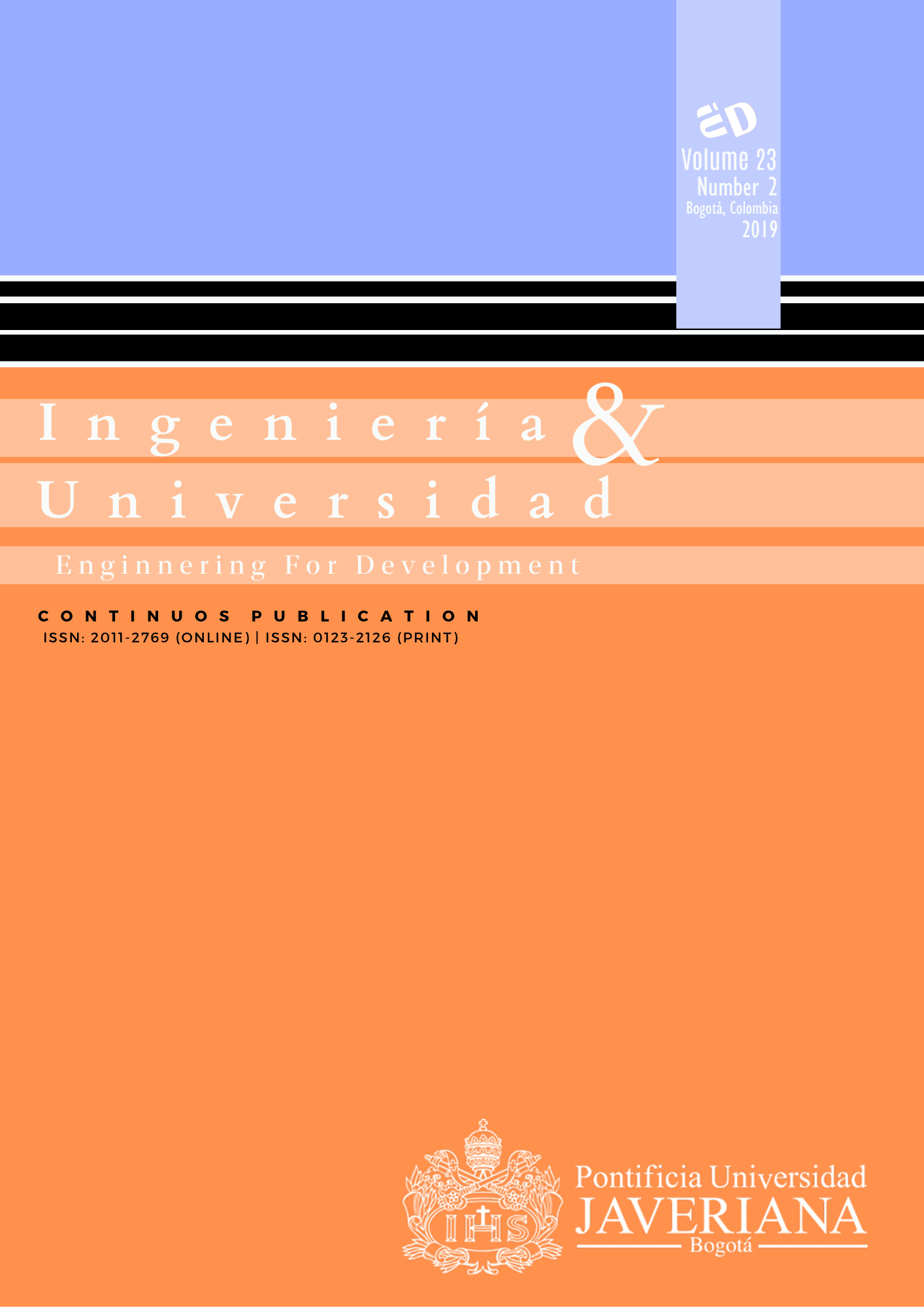Abstract
Objective: This article proposes a prediction model applicable to the propagation of noise generated by fixed sources as the result of the analysis of the phenomena related to the generation and propagation of sound levels and the subsequent correlation between the estimated levels and the data recorded in the field. Materials and methods: An experimental program was designed that included the measurement of sound pressure levels with a sound level meter in free field conditions for different weather conditions and distances from the noise emission source for comparison with the levels estimated by ISO 9613 Part 2. A statistical analysis of the data recorded in the field was performed to observe their dependence on the meteorological variables recorded during the measurements. Results and discussion: The standard error for the proposed prediction method is 11.4 dB(A), and the absolute average error is 9.1 dB(A). The correlation coefficient of the proposed model is 0.87. A statistically significant relationship exists between the variables at the 95 % confidence level. Conclusion: A propagation model that presented a better fit than the method of ISO 9613 Part 2 and a higher correlation coefficient was obtained.
[2] M. Wondollek, “Sound from wind turbines in forest areas,” Uppsala Univ., Uppsala, Sweden, Tech. Rep., 2009.
[3] M. Bérengier et al., “Outdoor sound propagation: A short review on analytical and numerical approaches,” Acta Acust. United Ac., vol. 89, no. 6, pp. 980–991. [Online]. Available:https://www.ingentaconnect.com/content/dav/aaua/2003/00000089/00000006/art00009?trendmd-shared=0
[4] K. Attenborough, “Developments in modelling and measuring ground impedance,” in 17th Int. Congr. Acoustics, 2002, pp. 236–237.
[5] ISO 9613-2:1996. Acoustics: Attenuation of sound during propagation outdoors. Part 2: General method of calculation, 1996.
[6] National Physical Laboratory, Guide to Predictive Modelling for Environmental Noise Assessment. London: National Physical Laboratory, 2007, pp. 1–30.
[7] G. van den Berg, “The sound of high winds: The effect of atmospheric stability on wind turbine sound and microphone noise,” Ph.D. dissertation, Univ. Groningen, Groningen, Netherlands, 2006.
[8] J. Cummings, “The variability factor in wind turbine noise,” in 5th Int. Conf. Wind Turbine Noise, Denver, 2013, pp. 1–17.
[9] ISO 1996-1:2003. Acoustics: Description, measurement and assessment of environmental noise. Part 1: Basic quantities and assessment procedures, 2003.
[10] ISO 3744:2010. Acoustics: Determination of sound power levels and sound energy levels of noise sources using sound pressure. Engineering methods for an essentially free field over a reflecting plane, 2010.
[11] L. Conceição, “Wind turbine noise prediction,” M.S. thesis, Eng. Aeroesp., Ins. Sup. Téc., Univ. Téc. Lisboa, Lisboa, Portugal, 2008.
[12] P. Moriarty and P. Migliore, “Semi-empirical aeroacoustic noise prediction code for wind turbines,” Nat. Ren. Energy Lab., Dec. 2003. [Online]. Available: http://citeseerx.ist.psu.edu/viewdoc/download?
[13] W. Zhu, “Modelling of noise from wind turbines,” M.S. thesis, Wind Energy, Tech. Univ. Denmark, Lyngby, Denmark, 2004.
[14] S. Hoogzaad, “Measuring and calculating turbine noise immission in the Netherlands,” in IEA Wind expert meeting sound propag. mod., Stockholm, 2009, pp. 7–16. Available: http://bit.ly/2LsNRUj
[15] S. Oerlemans et al., “Location and quantification of noise sources on a wind turbine,” J. Sound Vibration, vol. 299, no. 4-5, pp. 869–883, Feb. 2007. doi: 10.1016/j.jsv.2006.07.032
[16] K. Attenborough, “A review of ground impedance models for propagation modelling,” in Forum Acusticum Sevilla, 2002, pp. 1–6.
[17] J. Prospathopoulos and S. Voutsinas, “Application of a ray theory model to the prediction of noise emission from isolated wind turbines and wind parks,” Wind Energy, vol. 10, no. 2, pp. 103–119, Mar. 2007. doi: 10.1002/we.211
[18] P. Fuglsang and H. Aagaard, “Implementation and verification of an aeroacoustic noise prediction model for wind turbines,” Risø Nat. Lab.Mar.1996.[Online].Available:http://orbit.dtu.dk/fedora/objects/orbit:90419/datastreams/file_e8a71a1b-af6e-4b39-a587f0c70097d5ac/content
[19] H. Kruse, “In-situ measurement of ground impedances,” Ph.D. dissertation, Fakultät Mathematik Naturwissenschaften Carl Ossietzky, Univ. Oldenburg, Oldenburg, Germany, 2008.
[20] J. S. Lamancusa, Noise Control. Pennsylvania: Pennsylvania State University, 2000.
[21] F. Molina, O. Rengifo, and F. Vélez, “Modelo de dispersión gaussiano de contaminantes atmosféricos,” Rev. AINSA, vol. 13, no. 1, pp 33–47, En. 1993.
[22] C. A. Echeverri et al., “Simulación de ruido de tránsito automotor como herramienta para el rediseño de rutas de transporte público colectivo en el municipio de Medellín,” Rev. Ing. Univ. de Medellín, vol. 10, no. 18, pp. 19–29, Jun. 2011. Available: http://bit.ly/2Yc09Xf
This journal is registered under a Creative Commons Attribution 4.0 International Public License. Thus, this work may be reproduced, distributed, and publicly shared in digital format, as long as the names of the authors and Pontificia Universidad Javeriana are acknowledged. Others are allowed to quote, adapt, transform, auto-archive, republish, and create based on this material, for any purpose (even commercial ones), provided the authorship is duly acknowledged, a link to the original work is provided, and it is specified if changes have been made. Pontificia Universidad Javeriana does not hold the rights of published works and the authors are solely responsible for the contents of their works; they keep the moral, intellectual, privacy, and publicity rights.
Approving the intervention of the work (review, copy-editing, translation, layout) and the following outreach, are granted through an use license and not through an assignment of rights. This means the journal and Pontificia Universidad Javeriana cannot be held responsible for any ethical malpractice by the authors. As a consequence of the protection granted by the use license, the journal is not required to publish recantations or modify information already published, unless the errata stems from the editorial management process. Publishing contents in this journal does not generate royalties for contributors.



